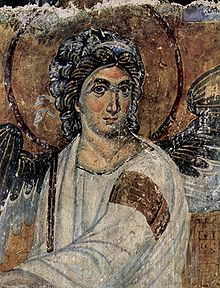

White Angel (Serbian: Бели анђео / Beli anđeo) is a detail of one of the best known frescoes in Serbian culture[1] in the Mileševa monastery, Mironosice na Hristovom grobu (Мироносице на Христовом гробу, the Myrrhbearers at Christ's tomb),[2] dated c. 1235 in Serbia during the reign of King Stephen Vladislav I of Serbia. Considered one of the most beautiful works of Serbian and European art from the High Middle Ages, this fresco is considered to be one of the great achievements in European painting.[2] It depicts the arrival of the myrrhbearers at the tomb of Christ on Sunday morning, after the events of the Crucifixion. Sitting on the stone is the Angel of the Lord dressed in a white chiton, whose arm shows the place of Christ's resurrection, and his empty tomb.
- ^ "White Angel – the Mileševa monastery". Via Balkans Travel Portal. 22 December 2010. Retrieved 19 December 2014.
- ^ a b "Manastir Mileševa - crkva Belog anđela" [Mileševa Monastery - the Church if the White Angel] (in Serbian). Večernje novosti. 5 August 2012. Retrieved 19 December 2014.